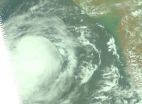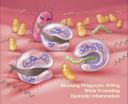(Press-News.org) Tropical Cyclone 02A has consolidated and strengthened over a 24 hour period between June 10 and 11 and an image from NASA's Aqua satellite showed a more rounded tropical storm, despite wind shear.
As Tropical Cyclone 02A consolidated and strengthened into a tropical storm it was re-named Nanauk. NASA's Aqua satellite passed over Nanauk on June 11 at 08:29 UTC (4:29 a.m. EDT) and the Atmospheric Infrared Sounder (AIRS) captured an infrared and near-infrared image of the storm. The near-infrared image provided an almost visible look at the clouds that revealed a well-rounded tropical cyclone with good circulation. The infrared image showed that the storms that surrounded the center of circulation had very cold and high cloud tops. The AIRS images were created by NASA's Jet Propulsion Laboratory in Pasadena, California.
Animated enhanced infrared satellite imagery shows that a large area of strong convection and building thunderstorms has continued over the low-level circulation center. Nanauk is still being buffeted by moderate to strong easterly vertical wind shear (20 to 30 knots). The wind shear has pushed the strongest thunderstorms into the western quadrant of the storm.
By 1500 UTC (11 a.m. EDT) Tropical cyclone Nanauk's maximum sustained winds were near 55 knots. It was centered near 17.5 north latitude and 65.8 east longitude, about 452 nautical miles east-southeast of Masirah Island. Nanauk was moving to the west-northwest at 6 knots.
Forecasters at the Joint Typhoon Warning Center expect Nanauk to continue strengthening for another day and a half before running into higher wind shear and dry air as it approaches the Arabian Peninsula.
INFORMATION:
A NASA view of Tropical Cyclone Nanauk in the Arabian Sea
2014-06-11
ELSE PRESS RELEASES FROM THIS DATE:
Gum disease bacteria selectively disarm immune system, Penn study finds
2014-06-11
The human body is comprised of roughly 10 times more bacterial cells than human cells. In healthy people, these bacteria are typically harmless and often helpful, keeping disease-causing microbes at bay. But, when disturbances knock these bacterial populations out of balance, illnesses can arise. Periodontitis, a severe form of gum disease, is one example.
In a new study, University of Pennsylvania researchers show that bacteria responsible for many cases of periodontitis cause this imbalance, known as dysbiosis, with a sophisticated, two-prong manipulation of the human ...
Migrating north may trigger immediate health declines among Mexicans
2014-06-11
PRINCETON, N.J.—Mexican immigrants who relocate to the United States often face barriers like poorly paying jobs, crowded housing and family separation. Such obstacles – including the migration process itself – may be detrimental to the health of Mexican immigrants, especially those who have recently moved.
A study led by Princeton University's Woodrow Wilson School of Public and International Affairs finds that Mexican immigrants who relocate to the United States are more likely to experience declines in health within a short time period compared with other Mexicans. ...
New study finds Internet not responsible for dying newspapers
2014-06-11
We all know that the Internet has killed the traditional newspaper trade, right? After all, until the general population started interacting with the web in the mid-90s, the newspaper business was thriving—offering readers top notch journalism and pages of ads.
But a recently-published study finds that we may be all wrong about the role of the Internet in the decline of newspapers.
According to research by University of Chicago Booth School of Business Professor Matthew Gentzkow, assumptions about journalism are based on three false premises.
In his new paper, "Trading ...
Study shows Deepwater Horizon crude oil impairs swimming performance of juvenile mahi-mahi
2014-06-11
VIDEO:
This shows juvenile Mahi-mahi in swim tunnel, which allows scientists to monitor metabolic rate swim performance.
Click here for more information.
MIAMI – A new study led by University of Miami (UM) Rosenstiel School of Marine and Atmospheric Science scientists showed up to a 37% decrease in overall swimming performance of Deepwater Horizon oil-exposed juvenile mahi-mahi. The findings reveal the toxic effects of crude oil on ecologically and commercially valuable fish ...
Survey: Almost all adult Texans knew about Health Insurance Marketplace during open enrollment
2014-06-11
HOUSTON – (June 11, 2014) – Almost all adult Texans were aware of the Affordable Care Act's Health Insurance Marketplace before the open-enrollment period ended March 31, according to a report released today by Rice University's Baker Institute for Public Policy and the Episcopal Health Foundation.
The report also found that an estimated 2 million Texans looked for information about the Marketplace and found the federal healthcare.gov website generally helpful. Almost half of Texans who visited the site wanted to purchase insurance or check their eligibility for a ...
White bread helps boost some of the gut's 'good' microbes
2014-06-11
White-bread lovers take heart. Scientists are now reporting that this much-maligned food seems to encourage the growth of some of our most helpful inhabitants — beneficial gut bacteria. In addition to this surprising find, their study in ACS' Journal of Agricultural and Food Chemistry also revealed that when looking at effects of food on our "microbiomes," considering the whole diet, not just individual ingredients, is critical.
Sonia González and colleagues note that the bacteria in our guts, or our microbiome, play an important role in our health. When certain populations ...
Researchers uncover common heart drug's link to diabetes
2014-06-11
Hamilton, ON (June 11, 2014) - McMaster University researchers may have found a novel way to suppress the devastating side effect of statins, one of the worlds' most widely used drugs to lower cholesterol and prevent heart disease.
The research team—led by Jonathan Schertzer, assistant professor of Biochemistry and Biomedical Sciences and Canadian Diabetes Association Scholar—discovered one of the pathways that link statins to diabetes. Their findings could lead to the next generation of statins by informing potential combination therapies while taking the drug.
Approximately ...
Study identifies risk factors for hospital readmissions
2014-06-11
WINSTON-SALEM, N.C. – June 11, 2014 – Hospital readmission, an important measure of quality care, costs the United States an estimated $17 billion each year. And according to the Centers for Medicare and Medicaid Services (CMS), about half of those readmissions could be avoided.
Therefore, there is significant interest in identifying factors that influence readmission rates, especially those that can be identified prior to discharge.
To pinpoint which stroke patients are most at risk, researchers at Wake Forest Baptist Medical Center undertook a retrospective case-control ...
Peer pressure is weaker for kids to quit smoking
2014-06-11
Adolescents tend to be more powerful in influencing their friends to start smoking than in helping them to quit, according to sociologists.
In a study of adolescent friendship networks and smoking use over time, the researchers found that friends exert influence on their peers to both start and quit smoking, but the influence to start is stronger.
"What we found is that social influence matters, it leads nonsmoking friends into smoking and nonsmoking friends can turn smoking friends into nonsmokers," said Steven Haas, associate professor of sociology and demography, ...
Sun emits 3 X-class flares in 2 days
2014-06-11
On June 11, 2014, the sun erupted with its third X-class flare in two days. The flare was classified as an X1.0 and it peaked at 5:06 a.m. EDT. Images of the flare were captured by NASA's Solar Dynamics Observatory. All three flares originated from an active region on the sun that recently rotated into view over the left limb of the sun.
To see how this event may affect Earth, please visit NOAA's Space Weather Prediction Center at http://spaceweather.gov, the U.S. government's official source for space weather forecasts, alerts, watches and warnings.
To see a video ...




